The Digitization of the Economy and the New Dynamics of Industrial Firms-Juniper Publishers
Juniper Publishers-Social Anthropology
Abstract
The digital revolution imposes new modes of
consumption and production. Internet, networks, big data, information
flows, connected objects, applied services: the whole ecosystem is
modified. Beyond the major socio-economic issues, there are upheavals in
geopolitical equilibrium and the emergence of a new economic order,
despite low levels of growth. Leading firms, such as GAFAM, are adopting
monopolistics strategies that threaten the major market equilibria and
force us to question the regulatory instruments.
Keywords: Digitization; Innovation; Organization; Model; Industry; Firms; Performance; Growth; Globalization; Local Development
Introduction
Before the massive spread of Internet in the 1990s,
the media markets were compartmentalized. The integration of large
groups was mainly vertical, thanks to deregulation initiated in the
field of television (ABC, Disney, AOL-Time Warner). This structuring has
been completely modified with the arrival of digital technologies.
Historical groups in this field are gradually entering into competition
with others from related fields such as networks, operating systems,
computer equipments, Internet platforms, etc. This is the phenomenon of
verticalization of the value chain » often emphasized by Lombard [1,2].
New digital giants are born: the GAFA or GAFAM Google, Apple, Facebook,
Amazon and Microsoft.
Henceforth, the goal is to make a coherent ecosystem
mastering at the same time, upstream the constraints related to the
setting up of the networks and supports carrying the information
(containers) and, downstream the expectations of the final users in
terms of both basic services and more sophisticated digital solutions
(contents). The market structure is oligopolistic. Therefore,
competition occurs in an environment where both competitors and partners
coexist. Indeed, the actors are in coopetition as indicated by Rosele
Chim [3-8] examining the classical theories on competition and those on
cooperation. Thus, they compete on certain markets or segments and
cooperate on others, each one seeking to satisfy a targeted demand
according to his level of specialization or his core business.
The digital revolution is in processing and imposes
new modes of consumption and new business relationships. Several
questions
then arise. What are the effects of training on organizational models,
distribution methods, the distribution of employment, which finally
question labor law and social protection? To what extent can businesses
reinvent themselves to adapt to these significant changes? How can
individuals and society be able to cope with the rise of the vast
process of disintermediation that is taking place on the targeted
markets (the phenomenon of uberization of the economy)? All these
questions are essential as this process is altering our vision of the
world and is modifying our practices.
Our Study Presents Three Highlights that Focus on These Issues
a. firstly, the digitization as a factor of a new industrial economic order;
b. secondly, the new power of firms thanks to the multiplier networks of the current revolution;
c. finally, the risks of imbalance of the system and possible regulation instruments.
The Digitization for a New Economic Order
New Information and Communication Technologies
(NICTs) have often given the feeling of the appearance of « New Economy »
compared to « Old Economy ». The configurations outlined by the
technological alliances of firms propelled the industrialized countries
into the emergence of a long cycle of growth with strong disruptions.
Economic renewal puts traditional analysis to the test. Perceptions are
varied between electronic economy, digital
economy and industry 4.0. The field covered by digital economy
is very distinctive.
Approach and Framework of Analysis
Let us choose the following approach: all economic and social
activities using internet networks, connected objects, electronic
sensors that mobilize aggregation of « big data » for the treatment
of information of their entire value chain from the producer to
the final customer. Today modern firms must first create desires
in the consumer’s life in order to be able to impose themselves
as a producer guaranteeing their satisfaction. In Galbraith [9]
revised sequence », in contrast to classical industry where offer
for goods and services must satisfy demand of consumers, it is
the individual with unlimited needs who serves the expansion of
economic structures.
Would demand dictate its law to offer? Maybe indirectly,
unbeknownst to consumers. Apple, like other digital giants, did it
not captivate its customers to sell them the created applications
and services? Indeed, the dynamics of the entire ecosystem is
based on the « manufacture » of a being in the grip of the need
to consume. The latter is the means likely to ensure the growth
for growth that presides over the decisions of the technostructure.
As technology and power of computation are no longer limiting
factors, firms seek to collect considerable data, which are then
aggregated, processed, stored. This information is useful for
controlling the production process (producers) and better market
expectations (customers).
The changes brought about by digital technology compel
world-class firms, as well as smaller firms, to permanent
adaptations, both technologically and organizationally because
of the change in uses, information and culture. This economy
integrates new networks that, beyond new activities (specific
services, business creation), lead to better performance (energy,
industrial, environmental) through lean management and more
« smart » processes. Here the notion of supply chain appears
essential to the extent that manufacturers seek to pool their
resources, to create synergies, particularly by developing common
supply platforms to gain advantage over competitors.
How do these mutations take place in the countries? Take the
case of France and Germany. According to the Economic Analysis
Council (2015), France can rely on the strengths that constitute
a significant demand, the flexibility allowed by the status of the
auto-entrepreneur, an authority of experienced competition and a
proactive policy of access to data. On the other hand, it is lagging
on the supply side. The main reason for this situation is overly
rigid sectoral regulations and a poorly adapted financing structure
to minimize this gap, even to conquer a leadership position, France
must notably be tolerant with its sectoral regulations, in order to
boost the experimentation of new business models and promote
healthy competition.
Moreover, Germany has launched a major project to
digitize its industry since the end of 2012 in order to maintain
its competitiveness. The challenge for businesses is to move
from today’s centralized management of their production to
decentralized management. In the core of factories of the future,
faster, less energy efficient, more flexible, we find Internet
and a new discipline: cyberphysics. In industry 4.0, there is a
generalization of embedded systems, softwares, flow and data
management software. They must allow a better communication
between the machines and a better interactivity man-machine.
The observation thus established allows to better identify the
more serious issues, especially for the industry that is at the heart
of these changes both internally (optimization of organizational
processes, adaptation or renewal of the production tool) and
externally (changes in regulations, customer satisfaction).
Study of Socio-Economic Issues
On one hand, the digitization appears as a simple evolution
because of its very weak ripple effects on all sectors of economic
activity and on the employment, even if we can recognize its role
of catalyst in the third industrial revolution. The machine in some
jobs replaces man but, for all that, there is no increase in production
yields due to technical progress as in the 20th century. Gordon
(2016) believes that this revolution is not able to have impacts
with the same intensity as the two previous ones: « washing
machine contributed more to emancipation and quality of life than
smartphone ». « Elevator and refrigerator did more than Internet
». It only concerns communication and entertainment, at most
7% of GDP. Even the big data, used in marketing and technicalcommercial
services, would not have a significant scope. The
same is true for employment effects. Robert Gordon recalls that
the United States is today in a situation of almost full employment
which challenges us as to the reality of the shocks of digitization
of the economy.
On other hand, it is believed that the world is truly entering a
new technological era and prefers to highlight the many virtuous
innovations. According to Joseph Alois SCHUMPETER, successive
shocks or waves of upswings and downswings have impacted
society and punctuated its transformations, since the birth of
industrial capitalism in the nineteenth century. Entrepreneur or
innovator is essential in Schumpeter analysis of the process of
development which is dynamic and discontinuous. Innovations in
one field of activities can induce other innovations in related fields
(Figure 1).
The Following Indicators Also Show that the Digital Revolution is in Processing
a. Increase in productivity gains, after a sharp slowdown at the
end of the « Thirty Glorious years » until the mid-1990s;
b. Creation of productivity gains in a very singular way in
services whose share exceeds 75% in the economic sectors;
c. Considering the energy constraint and the availability of raw
materials that has changed the perception of consumption
and renewal of resources;
d. Measure’s evolution of wealth’s level: from GDP to the HDI.
Wealth and industrial power could not be measured only
by business value added, social inequality or poverty level,
but also since the citizens’ willingness to build a fairer and
healthier society (system of health education, unemployment
insurance). In the sense of Amartya SEN (1990), the digital
does not escape these choices of access to knowledge and
leisure for all people with the development of more and more
« free » applied services;
e. Need or obligation of technological breakthrough for
businesses due to the preeminence of advanced computing
(artificial intelligence , exploitation of big data, exploitation
of cloud), also the proliferation of connected objects (link
between the physical object and the digital with the problems
related to the recovery of data as well as their processing and
storage), and then the democratization of advanced robotics
(cobots, collaborative robots, autonomous machines).
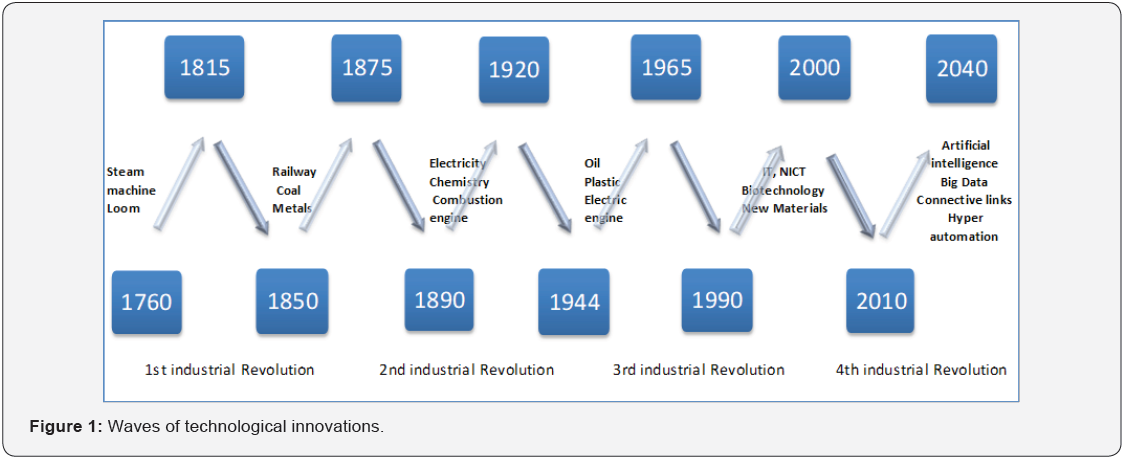
Similarly, the evolution of human-machine relations challenges
us: do need and use justify production when machine makes easier
access to information and decision-making? Permanently, the use
of network opens new perspectives to Internet users and implicitly
changes their behavior. Internet is the main model. Originally mass
media, nowadays social space where communication by text and
image is instant and unlimited, consequently it becomes a social
network (Facebook, Twitter, LinkedIn and more).
Consumer’s behavior as firm’s behavior has evolved in the
same way. All branches of industry have become those of the
NICT industries [5]. These last ones seek to better know the
customer to better satisfy him. Hence the demand is more volatile,
unpredictable, and the success of firms no longer depends on mass
production and the search for efficiency under cost constraint
through economies of scale, but the speed and flexibility of the
response to market demands with more personalized and higher
quality products. Industry should gain in competitiveness thanks
to new technologies (connected machines, additive manufacturing,
process digitization, cyber-production system).
Objects that are more and more connected are not worth their
own value, but rather associated services, most often in online
space. The challenge for businesses is to find even smarter processes
to adapt. In factories, performance management is measured by
the flexibility of production, the traceability of information in the
production process and energy savings. Contemporary economic
philosophy [10,11] reminds us that: we are currently experiencing
a period of immense change, comparable to the end of the Roman
Empire or the Renaissance. Our Western societies have already
experienced two great revolutions: the transition from oral to
written, then from written to print. The third is the transition from
print to new technologies, equally important. This change involves
major upheavals at all levels.
Upheavals and Emergence of a New Model
Technology is a factor of rupture, destabilization, change.
The importance of geopolitical upheavals or economic stakes is
in line with the strong and sustained growth of firms in the most
developed countries. Indeed, these large organizations stand out
in the world market by their financial weight, the multiplicity of
defended interests, the extent of production and distribution sites
and their spheres of influence, which are beyond the legal, political
and economic power of the host States.
In 2016, the technology sector outperforms the financial
sector as indicated by the PwC annual ranking of the world top
100 market capitalizations. GAFAM are in the first place among
American firms that remain globally the most dynamic and the
best valued in the world: they represent 54% of the top 100 firms,
ahead of those from China and Hong Kong (11%), the United
Kingdom (7%), Germany (5%), France (4%) or Japan (4%). Their level of market capitalization has more than doubled since 2009
reaching $ 16,245 billion in 2015 and $ 15,577 billion in 2016.
This figure is comparable to US GDP ($ 18,624 billion in 2016).
More specifically about the weight and influence GAFAM,
we can make the following comparison between their market
capitalization and the GDP of certain countries: Note that the
stock market valuation of Apple is slightly lower than the GDP
of the Netherlands, that of Microsoft is comparable to the GDP of
Colombia or exceeds that of Switzerland. Similarly, the financial
weight of GAFAM exceeds the wealth created by France and is at
the same level as that of an emerging country such as Brazil (which
produces a wealth superior to France of nearly 15%) (Tables 1 &
2).
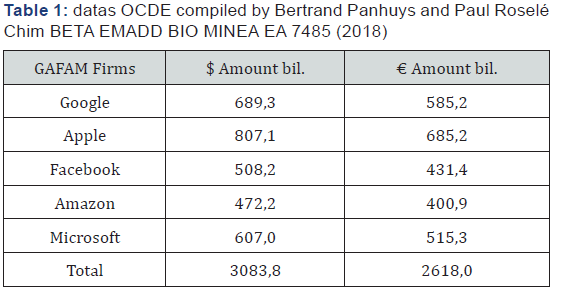
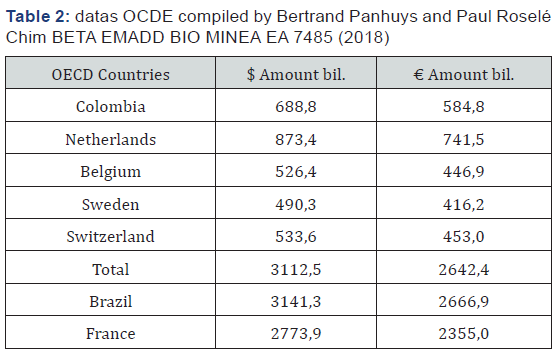
Moreover, in the field of the Internet, we note that American
and Chinese firms also exercise significant power: The United
States account for 72% of the top 50 world sites against 16% for
China. The open path in this field and in those directly associated
with it (networks, IT, multimedia, etc.) suggests the emergence of
a bipolar world without the European Union [12]. By observing
the dynamics of European firms on highly technological and
strategic markets, we can notice the strong skills required in
digital technology. For example, in aeronautics (Airbus, Safran,
Thalès, Rolls Royce, Zodiac) or space (launchers, satellites) with
the operational implementation of the future Galileo geolocation
system competing with the American GPS, the multipolarite could
be preserved. European Union thus strengthens its position in the
global « representative » of Internet governance by influencing
political orientations and industrial strategies to better support
European firms in the digital transition.
Beyond the geopolitical stakes, a new model is setting up.
Firms now need « real time » signals from the evolution of
the market. They set up ad hoc processes that can collect and
interpret these information flows. The goal is not to miss the
next technical « disruption » a total break with the previous
phase as it generates radical changes. Disruptive innovation is a
breakthrough innovation, as opposed to incremental innovation,
which merely optimizes the existing [13]. Thus, the firms
potentially in commercial competition can form a network to work
in partnership, in order to increase the creation opportunities in
adequation with the expectations of the market. They also gain
in performance by using their internal resources and relying on
external resources in the fields of competence dedicated to each
provider. This is the rule of coopetition according to Rosele Chim
[8].
By revolutionizing organizational models and modes of
distribution, digital economy first imposes new ways of consuming
characterized by the « dematerialization » of consumer products.
The digital revolution disrupts certain business models in many
economic areas or traditional media [5,8]. It bypasses service
providers or formerly established intermediaries. As such, it
initiates a vast process of « disintermediation » which favors the
mediation of the new giants of the Net on the concerned markets.
This is the phenomenon of uberization of the economy according
to Bassoni and Joux [14,15].
The contemporary period is marked by an economic model
of products and services permanently free. This is a real cultural
and sociological revolution for users who no longer must pay to
consume their information assets: online newspapers and music,
radio shows in podcasts, TV, videos, movies in streaming. They
can now go on platforms to perform their transactions (Amazon),
to access applications (windows, iTunes) or to perform their
research or information (Google, traditional online media sites).
Greffe and Sonnac [16] consider that these platforms allow, on one
hand, to make quantitative and qualitative audiences available to
advertisers, and on other hand, to push for the development of
specific business models and dynamics. Here the success consists
in the ability of each to structure its users in communities offer
them services and tools that will facilitate their virtual social
interactions.
Countries also can take advantage of these
technological
advances by focusing on household equipment and encouraging
businesses to invest in Research and Development to make full use
of the new offered capabilities (e-commerce, client and supplier
data processing software, secure transactions) (Figure 2). The
chart above illustrates the digital divide between European
countries, with some not giving consumers or businesses the
opportunity to use new technologies to facilitate adaptation to
new models of trade, transactions and management. It is also
noted that it is mainly the more affluent countries of the North
which have fully changed in this new economy. As an example, we
can cite the success of the Israeli industrial model through its role as
active investor, its directive steering and a strong tax incentive
[17]. In fact, for nearly 15 years, the government has successfully
launched a $ 100 million venture capital fund to help create startups
and high-tech, high value-added projects.
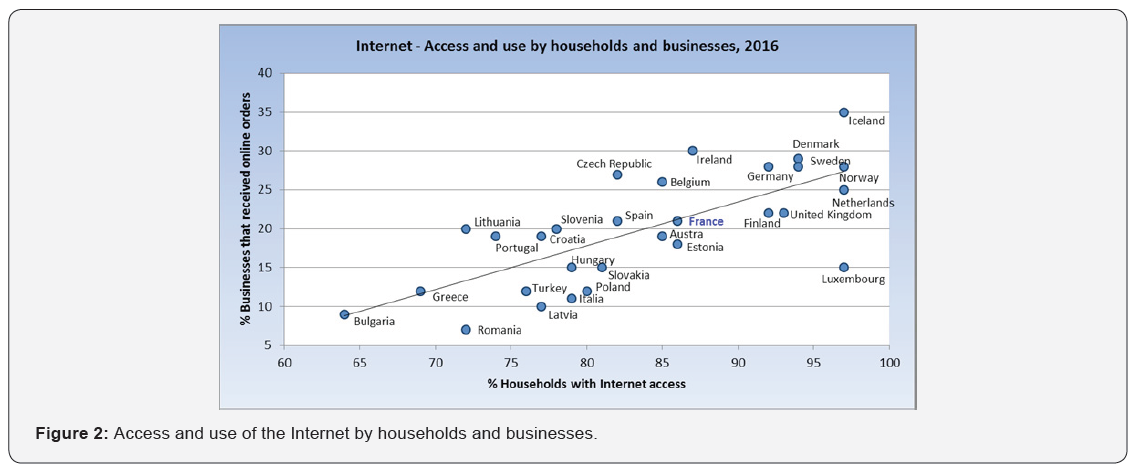
Israel has become the first country in the world with the
highest ratio of R&D expenditures to GDP, far ahead of the United
States, the OECD countries and France. Israel has 4.3% in 2010,
against 2.8%, 2.3% and 2.2% for other countries respectively.
Finally, the consumption habits of citizens have been considerably
modified, demanding a strong and rapid adaptation of businesses
as well as their production process. Hence the emergence of a new
economic model where firms will develop another form of power.
The New Power of Firms
The movie and audiovisual programs industry in the United
States as well as in Europe, in addition to France, constitute
the illustrative field of firms constantly changing the strategic
alliances [18,19].
Business Strategy and Power of Market
The long history of industrial crises in the field of movies and
television highlights technical and technological transformations
that have triggered the disruption of NICTs [3,6]. We observed in
the 1980s, 1990s and 2000s a vast movement of concentration
in the world of the media. Behind the American Majors, like
the networks of Europe, the dynamics of the technological
clusters is intense. Controlling products and markets presents
several explanatory factors: evolution of technologies including
digitization and compression of signals; d e r e g u l a t i o n
which leads to the end of natural monopolies for the exploitation
of networks and the provision of telecommunications services;
transformation of the competitive environment that will drive
players to massively diversify their activities towards the
multimedia markets following the collapse of the traditional
sectors of the electronics industry; current situation due to the
growing interest of consumers for activities related to multimedia
and which require firms to adapt.
In fact, the new competitors appear from very different fields:
network infrastructures, IT, audiovisual, publishing, distribution.
These firms that emerge seek to control programs (contents)
and distribution networks (containers) as explained Guillou and
Mouline [20,21]. The phenomenon of globalization, the expansion
of cultural and informational consumption, the power of the
market and the maintenance of the content industries, has spread
to the cultural, informational and communicational industries
outside the world. Major firms have emerged by mastering the
tools and new uses of the web. As an illustration, in the field of
music, the popularity of iTunes, Apple Music, YouTube, YouTube
Music remind traditional firms how much they are dependent on
the decisions of the giants of the Net, which threatens again the
recorded music market.
The successes of these new world leaders come from their
ability to force users to use their application or materials.
The work of Kelly, Shapiro and Varian [22,23] shows that the
consumer will find himself in a system quite different from that
of traditional neo-classical economics. Its purchasing autonomy
is subject to sometimes strong constraints. Indeed, the user of
certain technologies can be « locked » without being able to easily
change technology.
Like most global markets, Internet has an oligopolistic
structure with businesses that, because of their ability to impose
standards, tend towards a dominant or even hegemonic position.
That allows to highlight three factors: drop in the costs of
technology, according to the MOORE law, permanent innovation
and intelligence. The cost of production of a smartphone is low in
view of the value of the components necessary for its manufacture,
in view also of the number of users as well as the applications and
operating systems developed and updated regularly in line. In this
context, we can understand that the movements of concentration continued with the development of Internet and associated
applications. Two main and indissociable reasons can be invoked:
on the one hand, the added-value chain linked to content and
the resulting wealth creation capabilities; on the other hand, the
structuring of the production of the containers and the search for
management optimization of trade flows and logistics necessary
for the distribution of final goods.
In fact, overall satisfaction depends both on the quality of the
products and services adapted to the expectations of consumers
and the organization of the market. For these leading firms,
purchasing has become a source of productivity. Because buyers,
faced with the multiplicity of information channels and orders,
want to see more complementarity between tools and better
harmonization of data collected by the company. Thus, the supply
function has evolved while allowing to provide innovative and
quality products, and avoiding stockouts, elements both costly for
the company and negative in terms of image and notoriety. It is
from now on the whole chain of value that the company considers
in the evaluation of its performance. It adapts in an almost iterative
way, according to the cycles of production and the evolution of the
competitive environment, all its processes for the realization of
the fixed objectives.
In this context, the control of costs or delays as well as the
control of the quality or the reliability of the final production
remain; but other indicators are also used to measure the success
of the corporate strategy: customer loyalty, improvement in
economic performance (sales, operating margin) or financial
performance (profit per share), promotion of image or brand,
innovation (R&D budget, collaboration with research laboratories,
patents pending), internal and external growth prospects for the
company (unprofitable activities outsourcing, key skills current
or future strengthening by training or recruiting the necessary
talents, positioning on international markets).
The situation we have just described makes it possible to
better understand the market power of these new players who,
taking advantage of the high expectations of consumers, manage
to make them captive. Nevertheless, other elements that did not
exist in the previous revolution must be considered to ensure their
strategic power: networks and empowerment.
The Era of Networking and Empowerment
Through networks, firms can adopt strategies to diversify their
activities. This allows, on the one hand, to erect barriers to entry
against potential competitors. According to Stigler [24], a barrier
to entry is a cost of production that must be charged by a firm
wishing to enter a market, without those already in place having
to do it. This offers the opportunity, on the other hand, to set up an
investment policy whose profitability is more secure. In fact, the
risk of loss is reduced because of the holding of a larger products
portfolio and profit prospects discounted on other markets. Megafirms
correspond to a global market and millions of captive users.
For the third type of firms after the multinationals, the
most important is not so much the gain in market shares as the
network constituted by the number of users who fuel the need for
development of closed mobile applications to the Internet service.
Competition is no longer at the level of the operating systems
but more platforms with data become permanent: innovation,
alliances, searching for external growth. Facebook confirms
it; according to manager Mark Zuckerberg, performance goes
through a more open and connected system.
Thanks to the increased use of digital channels and common
platforms for data exchange and processing, B2B is constantly
growing. Similarly, on the consumer side, the more widespread
use of Internet strongly influences exchanges between individuals
(online sales and purchases). « GAFAM deal with the same users
but with its own assets: mobile terminal, research browser,
advertising browser, cloud platform, community of developers »
according to Bourdin [12].
Nevertheless, several characteristics of these markets on
which these large firms are positioned, make it possible to
measure well the difficulties to maintain a stability of networks
and a continuous growth: First, they are hyper fragmented and
heterogeneous. Then the situations of dominant positions are
very quickly jostled because of the pressure of new entrants or
substitutable products. Lastly, product cycles are very short and
innovation processes are constantly improving. It is the result of
the search for creativity and permanent innovation that ultimately
leads to the development of new services and new markets. All
this poses significant risks to the market equilibrium and pushes
to question the means of regulation.
The Risks of Imbalance and the Search for Regulation
The 2007 crisis demonstrated the complexity of business
relationships, the inability to master information flows or to
predict the onset of a collapse of a growth and confidence-based
system. With the advent of digital technology, we can wonder,
beyond its beneficial effects on global economy, on its capacity
to create growth through technical progress and to ensure
an increase in social well-being. Finally, the combination of
financialization, digitization and globalization would constitute all
the explanatory factors for the deregulation of the system, with
each element allowing the other to increase its intensity and its
propagation.
The Relation Between Technical Progress and Growth
Many firms, like the media groups or giants of the
Net,
have gone through economic and organizational crises, forcing
them to reinvent themselves to survive Bassoni and Joux [15].
Businesses must constantly adapt their production model to
market developments. This external environment can be at
the same time very close (local market) or very distant (global
market) but impose very strong constraints to be considered in
the development strategy. According to Bassoni and Liautard [14], the
territories bear the stigma of the « creative destruction » that
Ja Schumpeter [25] explained. They are, over time, the theaters
where two concomitant and inextricably linked processes take
place: that of the decline of traditional activities and the rise of
new activities ».
This trend is well underway and affects all sectors of economy.
But a fundamental question arises: will this digital revolution
increase the productive capacity or, on the contrary, as Cohen
[26] asserts, that it will not bring anything comparable to the
technological revolutions related to the invention of electricity and
combustion engine? The report of slow economic growth observed
for thirty years in the United States, with a median income that no
longer progresses despite the arrival of digital technology, would
rather support the second thesis. The firm no longer creates
enough added value for the employment of additional staff and
for training effects in other economic sectors since it outsources
activities to subcontractors in a massive way.
In addition, compared to previous periods, the contribution of
technological progress generates insecurity by replacing jobs with
robots, with automation chains, with intelligent processes. 50%
of jobs would be threatened by the development of digitization. It
is the middle classes, the banks, the insurance businesses and the
administrations, which seem the most exposed by this evolution
of the employment because of the increase, on the one hand, of the
need of labor poorly qualified to carry out basic tasks and on the
other hand, of important resources released by and for those who
are behind this digital transformation. In the United States, 1% of
the richest people have seen their share in the GDP increase of 15
points in thirty years.
The challenge for the future is no longer to increase the
productivity of men at work (lower than in the 20th century),
robots and computers replacing them, but to redistribute the
profits and above all, to raise the level of well-being of all (education,
health, eco-citizenship, eco-transportation). The economic sphere
is turned to producing not goods but applications that provide
users with free information. As a result, what is of value it is what
escaped this free, it is the positional goods: where I live, or I send
my children to school, can I be healed in good conditions [26]. In
this context, France has made the implicit choice for three decades
of an economy without industry. In the charts below, we can
observe the place that France occupies among the industrialized
countries in the world and in Europe (Figure 3-5).
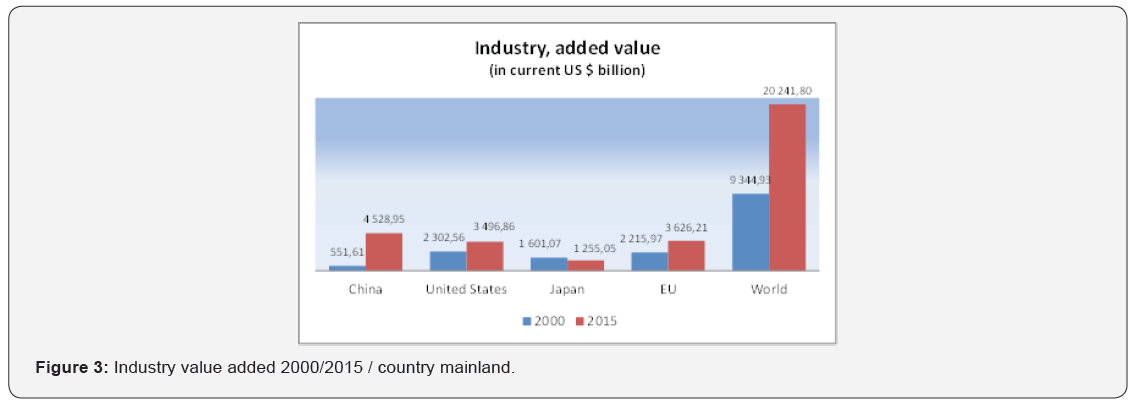
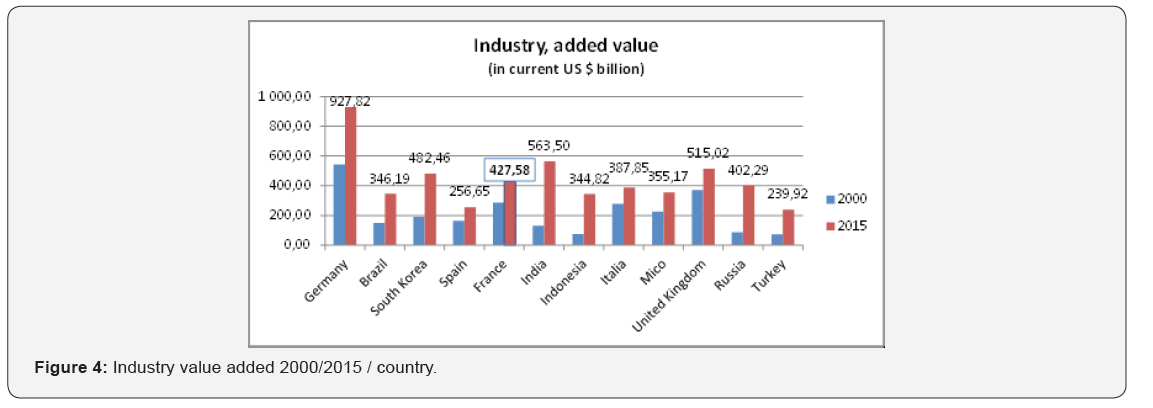
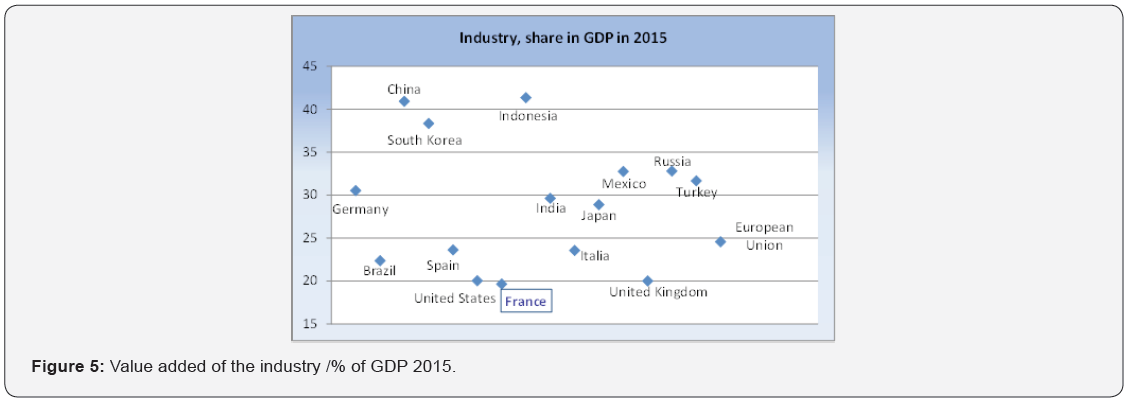
We can admit that between 2000 and 2015, the process of
industrialization concerns emerging countries and especially
China, which alone exceeds $ 4 500 billion in value added. The
BRIC group has recorded very strong growth, unlike European
countries which have not developed their production tools. South
Korea, in full industrial transformation, has managed in 15 years
to exceed the value added of France, Russia, Mexico or Indonesia.
This dynamic is explained by the importance of the share that some
countries devote to industry in GDP: over 35% in China, Indonesia
or South Korea, 30% in Germany, Mexico or Russia, France being
below 20%, like that of the United States or the United Kingdom.
In view of these elements and the trends that emerge, several
questions arise. The digital revolution and the challenges it poses
are not an opportunity for the implementation of a process of reindustrialization
and revitalization of businesses turning to more competitiveness. Will this revolution have the capacity to relocate
industrial activity that has disappeared to the extent that factories,
which have become more flexible and automated, have production
costs that are almost « insensitive » to the cost of labor?
Indeed, the previous revolution had put more on an increase
of the volumes to justify the economic investment and to increase
the production, the size and the costs of return of the businesses.
Today, the theoretical growth factors are based, at constant product
volumes, on the reduction of capital consumption and a return on
investment from higher capital employed. Nevertheless, thanks to
2008 crisis, the direct effects of digitization have been significantly
accentuated. It is the rise of unemployment, precarious jobs, the
decline in average wages, the growing deficit of foreign trade,
the obstacles to growth, the devitalization of territories, the
increased vulnerability of society. The sustainable development is
considered in some extent by a production turned to employment.
Indeed, the industry includes a mode of distribution of wealth
through the wage system, while the NICT model does without it by
accentuating the unemployment of performance and competence.
Six Orientations are Advocated
a. support creativity and human development through
the modernization of the education system, valuing the
imagination and taking risks;
b. develop economy based on quality and provided services;
c. renew the energy model and master consumption for all and
sustainably;
d. initiate a « big bang » of territories (mobilizing and structuring
projects);
e. put finance at the service of growth;
f. strengthen global influence capacity by improving the
competitiveness of firms and by acting within Europe to
rebalance competition between emerging countries and the
first industrialized countries.
g. These guidelines challenge the sustainability of development
and governance: govern differently to produce otherwise.
GAFAM and other high-tech companies have accompanied
digital change. It is a question of working in a transversal way in
collaboration with the actors of the market to advance the scientific
research, the development, the applications at the service of the
product. The goal is to move towards some form of social welfare
of individuals.
Global Competition, Strategic Coopetition and Risks of Collusion
Beyond the problems related to competition, there is the
question of the sharing of added value between the different
actors: service intermediaries (Facebook, Google), incumbent
operators (Orange, British Telecom), network and terminal
equipment manufacturers (Alcatel Lucent, Dassault System),
content producers (Disney, AOL-Time Warner, Newscorp). The
emergence of GAFAM and their mega-power was built through
major breakthroughs: hardware (Apple), search (Google),
e-commerce (Amazon), social (Facebook). Industry 4.0 offers
new perspectives of digital applications for the benefit of citizens,
customized products, needs and specific markets.
The search for an optimum of satisfaction goes through
the development of business networks, common platforms of exchanges, partnerships between the academic and scientific
world and that of companies, multiple collaborations in order to
answer the economic and societal problems. The stakes are up
to the challenges that we perceive in the 7 industry paradigms
4.0 described by Blanchet [27]: management of the complexity
induced by digitization allowing the customization of products
; industrial relocation near final markets with high automation
production processes ; dynamic and more efficient supply chain
(lean); end of the product-service divide and supplier-customer
reconciliation thanks to the data collected and which allow to
improve the quality of service and to optimize the life cycle; end of
the logic of an economy of scale, the new technologies implemented
mobilizing the physical asset more and allowing the passage from
a « push » logic (to manufacture to store) to a « pull » logic (to
make on command); end of Taylorism with learning organizations
and increased reality technologies (increased monitoring, remote
work, tele maintenance, remote factory inspection). more energyefficient
industry (circular economy), better integrated in its
territory of implantation (CSR approach) and more attractive [28-
31].
The coopetition practiced by most big firms that provides a
balance of power should gradually fade in favor of more intense
competition due to the increased development of networks, clouds
and big data. In this context, how to ensure balanced competition
for the benefit of consumers? The arrests, interrogations and
hearings in front of the institutions in the United States and the
recent trials in Europe against the GAFAM show the limits of the
digital economy where the influence of firms and markets exceeds
the power of States. Which regulatory instruments to implement?
Regulation Instruments
According to neo-classical economics, and particularly the
school of industrial organization, it is necessary to think of the
necessity of reinventing a more socially model of growth just by
integrating the future generations, more economical and more
durable. This seems conceivable in the evolution of economic
thinking, of industrial analysis, which is gradually considering the
human approach of the aleas of the conditions against growth. It
places greater emphasis on the training of precarious populations,
namely unemployed and unskilled, on the emergence of new
skills, on social innovation and on the optimization of available
resources in the light of the consumption [32-35].
Another vision encourages us to put forward rather the
voluntarist strategy aiming at the search for the competitivity of
the companies at the local scale of the territories to integrate in the
model of regulation all the societal evolutions. Thus, countries and
regions can exist in terms of industrial weight and have influence
in terms of geopolitical weight at the global level. Economic poles
in globalism would favor the emergence of high value-added
technologies sold in the world. Hence the questions about the
nature of the businesses in the future, their organization, their
production, their market and their process of survival [36-38].
The dynamics of liberalization is at the heart of digital economy
that cannot seek to control markets and firms whose field of action
is supra-national. There appears to be a temptation in the global
market between the return to protectionism on one side and the
intensification of liberalization on the other side. Indeed, there are
counter-powers to the large influence of digital economy:
the consumer is first, versatile and communicating globally via
networks and potentially sensitive to the image of the firm in case
of repeated and notorious; the competition is then stronger and
focused on innovation, structural and partnership organization;
the regulator is finally, on the lookout for any risk of technical, legal
or financial imbalance to guarantee an optimum of satisfaction to
the consumers and more broadly to the society [39-42]. This is a
form of declining general equilibrium with the Paretian optimum
since more CSR logic is considered with respect to the external
environment. And we find corroborated the principle of the
research of the balance between the industrial regulation and the
innovation [43,44].
Conclusion
The digital revolution has effects on all areas of society.
Consumption habits have been modified, pushing companies
to adapt their mode of production. GAFAM and new types of
companies from the Internet and the high-tech sectors stand out
thanks to their own identity and their capacity for innovation.
The power and influence of these organizations is significant
in achieving the balance of fragmented, heterogeneous and
volatile markets due to competitive pressures and ongoing
innovations. Liberalization is faced to protectionist temptations.
The context challenges the rationalization of organizational
models and productive activities, the mode of job destruction,
societal involvement and the method of profit compilation. States
are grappling with the model of digital economy and the dynamics
of a new type of industrial organization through the protection of
citizens (Google), the avoidance of instrumentation (Facebook),
the ecosystem predation (Amazon), the tax avoidance (Apple,
Google, Amazon, Airbnb). Adaptations are long term. The changes
are important.
For More Articles in Annals of Social Sciences & Management studies Please Click on: https://juniperpublishers.com/asm/index.php
For More Open Access Journals In Juniper Publishers Please Click on: https://juniperpublishers.com/index.php



Comments
Post a Comment